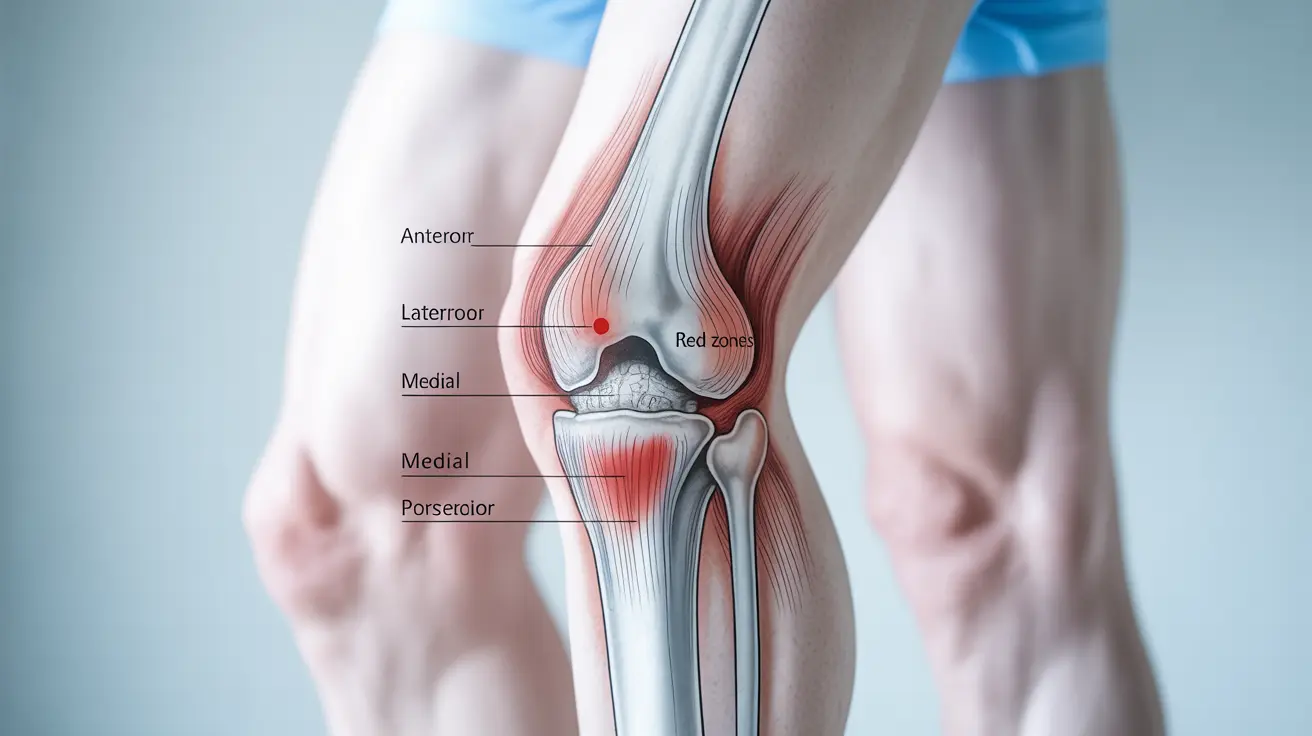Knee pain can be a challenging and complex issue, affecting people of all ages and activity levels. Understanding where your knee hurts is often the first crucial step toward identifying the underlying cause and getting appropriate treatment. This comprehensive guide will help you interpret what different knee pain locations might mean for your health.
By learning to pinpoint and describe the exact location of your knee pain, you can better communicate with healthcare providers and potentially speed up the diagnostic process. Let's explore how different pain locations can indicate specific conditions and when you should seek professional medical attention.
Front Knee Pain: Common Causes and Conditions
Pain in the front of the knee is one of the most frequently reported locations for knee discomfort. Common conditions associated with anterior knee pain include:
- Patellofemoral pain syndrome (runner's knee)
- Patellar tendinitis
- Chondromalacia patella
- Prepatellar bursitis
The specific location of front knee pain can provide valuable diagnostic clues. Pain directly under the kneecap often suggests patellofemoral issues, while pain above or below the kneecap might indicate tendon problems or bursitis.
Side Knee Pain: Understanding Lateral and Medial Discomfort
Outer (Lateral) Knee Pain
Pain on the outside of the knee often indicates specific conditions such as:
- Iliotibial band syndrome
- Lateral meniscus tears
- Lateral collateral ligament injuries
- Osteoarthritis
Inner (Medial) Knee Pain
When pain occurs on the inner side of the knee, common causes include:
- Medial collateral ligament injuries
- Medial meniscus tears
- Pes anserine bursitis
- Osteoarthritis affecting the medial compartment
Back of Knee Pain: Posterior Knee Conditions
Pain behind the knee might be related to:
- Baker's cyst
- Hamstring tendinitis
- Posterior cruciate ligament injuries
- Popliteal tendinitis
The characteristics of posterior knee pain, such as whether it's sharp, dull, or accompanied by swelling, can help determine the underlying condition.
When to Seek Medical Attention
Certain symptoms warrant immediate medical evaluation:
- Severe pain or swelling
- Inability to bear weight
- Visible deformity
- Fever accompanying knee pain
- Significant joint instability
- Pain that doesn't improve with rest
Treatment Approaches Based on Pain Location
Different pain locations often require specific treatment approaches. While some general measures like RICE (Rest, Ice, Compression, Elevation) can help many knee conditions, targeted treatments based on the exact location and cause of pain are typically most effective.
Frequently Asked Questions
What can the location of knee pain tell me about the possible causes of my discomfort?
The location of knee pain can provide significant clues about potential underlying conditions. Front knee pain often indicates patellofemoral issues or tendinitis, side pain might suggest ligament injuries or meniscus problems, and back knee pain could point to conditions like Baker's cysts or hamstring issues.
How can I use a knee pain location chart to help diagnose my knee problems?
A knee pain location chart helps you accurately identify and communicate the exact location of your pain to healthcare providers. By matching your pain location with common conditions affecting that area, you can better understand potential causes and seek appropriate medical attention.
What are the common conditions associated with pain in the front, sides, or back of the knee?
Front knee pain typically relates to patellofemoral conditions or patellar tendinitis. Side pain often indicates ligament injuries or meniscus tears, while back knee pain commonly suggests Baker's cysts or hamstring problems. Each location has distinct associated conditions that help guide diagnosis.
When should I see a doctor for knee pain based on its location and symptoms?
Seek immediate medical attention if you experience severe pain, significant swelling, inability to bear weight, visible deformity, or fever with knee pain. Persistent pain that doesn't improve with rest or pain that affects daily activities also warrants medical evaluation.
How does identifying the exact spot of knee pain guide treatment and management options?
The specific location of knee pain helps healthcare providers determine appropriate treatment plans. Different locations often require different approaches, from targeted exercises and physical therapy to specific medications or, in some cases, surgical intervention. Precise location identification leads to more effective, targeted treatment strategies.




